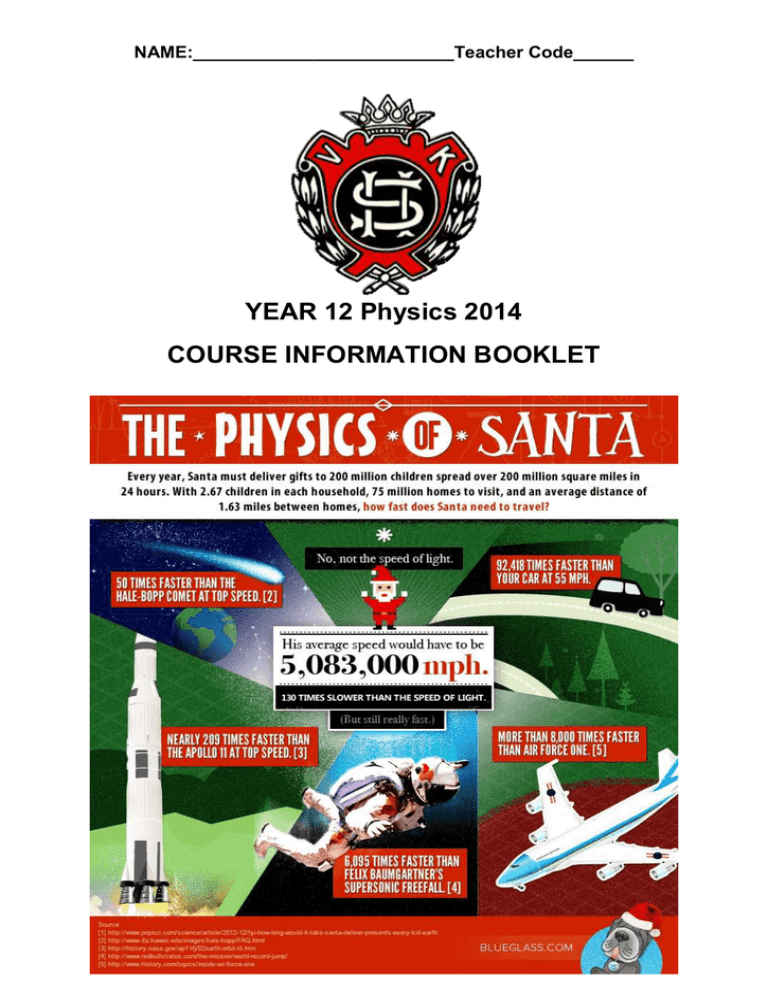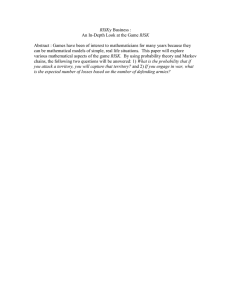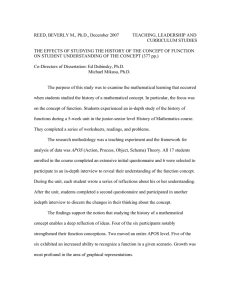YEAR 12 Physics 2014 COURSE INFORMATION BOOKLET
advertisement

NAME:__________________________Teacher Code______ YEAR 12 Physics 2014 COURSE INFORMATION BOOKLET YEAR 12 PHYSICS 2014 TERM ONE TERM TWO 1 27 Jan Course Confirmation Day 1 Teacher Only Day Year 9 Orientation Year 9 Orientation 5 May 2 3 Feb Whole School 12 May (total 380 half-days) TERM THREE TERM FOUR 21 July 13 Oct 28 July 20 Oct AS2.3 WAVES REVISION Waitangi Day 17 May 3 10 Feb 19 May 4 Aug 27 Oct Labour Day AS2.6 CONTINUED AS2.5 ATOMIC PHYSICS 4 17 Feb 26 May 11 Aug 3 Nov 5 24 Feb 2 Jun Queens Birthday 18 Aug 10 Nov NCEA BEGINS 6 3 Mar 9 Jun 25 Aug 17 Nov 7 10 Mar 16 Jun Mid Term Break 4 24 Nov 8 Sep 1 Dec 15 Sep School Exams 8 Dec AS2.4 MECHANICS AS2.6 ELECTROMAGNETISM /AS2.1 NON-LINEAR PRACTICAL PRACTICAL Mid Term Break 8 17 Mar Mid Term Break 23 Jun Feast Day 9 24 Mar 30 Jun End of Year Last day of Term 10 31 Mar 22 Sep Last Day School Exams Last day of Term 11 7 Apr 12 14 Apr Last day Good of Term Friday Holy Thursday 108 half-days 88 half-days 98 half-days 86 half-days Assessment Calendar Summary Achievement Standard Title INT/ EXT Details Time 2.5 Atomic Physics INT 2.1 Carry out a practical investigation to test a physics theory relating two variables in a non-linear relationship Mechanical systems INT 1 /2 period assessment. 4 period assessment Term 1 Week 7 Term 2 1 period practice test School exams Term 2 1 period practice test School exams. 1 period practice test School exams Term 2 2.4 2.3 Wave systems 2.6 Electrical systems. EXT EXT EXT Week 2 Week 1 Week 5 Term 3 Week 4 Level 2 Physics 2014 Internally Assessed Achievement Standards This year the course includes 2 internally assessed Achievement Standards. AS91168 Version 1 AS 91172 Version 1 AS 2.1 Carry out a practical physics investigation that leads to a non-linear mathematical relationship 4 credits AS 2.5 Demonstrate understanding of atomic and nuclear 3 credits physics Term 2 Week 2 Term 1 Week 7 These assessments are part of the formal assessment for your NCEA. This means that if you are absent you need to apply for a formal special consideration from Mrs Pigou. You will require a Medical Certificate and will need to provide evidence of your achievement by attending the catch up opportunity. If this is not possible you will NOT be able to be given credit for the Achievement Standard. As for any national assessment you must attend the assessment events to gain credit. There is no second opportunity for Achievement Standards. Externally Assessed Achievement Standards The following external Achievement standards will be offered in 2014. AS91170 Version 1 AS91171 Version 1 AS91173 Version 1 AS 2.3 Demonstrate understanding of wave 4 credits AS 2.4 Demonstrate understanding of mechanics 6 credits AS 2.6 Demonstrate understanding of electricity and electromagnetism 6 credits At the end of each unit there will be a knowledge test with NCEA style questions. These will provide practice assessment and be a guide to your progress. In September there will be a formal school exam, which will cover the externally assessed achievement standards in a similar format to the External Exam. The results from these formal assessments will be used in if a derived grade is required for the external NCEA exams in November. However if they have not been sat, the student will not be able to gain a derived grade in Chemistry for NCEA. Return of Assessments As soon as it is practical, assessments will be returned to students and gone over in class. Students are encouraged to ask for clarification and follow the school guidelines if there any problems. A written application for reconsideration can be made within 1 week of the return of the assessment. Each student will have a file stored by the teacher in which all assessments will be filed. Under no circumstances will these be allowed to go home. They are available at school for students to use for revision. Assessment material may be required for moderation by NZQA. Homework To achieve in Physics it is necessary to work steadily all year. Homework will be set. When formal work is not set you are expected to complete the exercises from your text. With each unit some task will be assigned in class and some will be completed at home. There will be a due date set when the tasks are to be finished and the tasks will be checked to monitor your progress. Regular homework is expected and it is your responsibility to develop good habits. Achievement Standard 2.1 Subject Reference Physics 2.1 Title Carry out a practical physics investigation that leads to a non-linear mathematical relationship Level 2 Subfield Science Domain Physics Credits 4 Assessment Internal Status Registered Status date 17 November 2011 Planned review date 31 December 2014 Date version published 17 November 2011 This achievement standard involves carrying out a practical physics investigation that leads to a non-linear mathematical relationship. Achievement Criteria Achievement Achievement with Merit Achievement with Excellence Carry out a practical physics investigation that leads to a non-linear mathematical relationship. Carry out an in-depth practical physics investigation that leads to a non-linear mathematical relationship. Carry out a comprehensive practical physics investigation that leads to a non-linear mathematical relationship. Explanatory Notes 1 Carry out a practical physics investigation involves: collecting data relevant to the aim based on the manipulation of the independent variable over a reasonable range and number of values drawing a graph that shows the relationship between the independent and dependent variables writing a conclusion which describes the type of mathematical relationship that exists between the variables. Carry out an in-depth practical physics investigation involves: controlling the variable(s) that could have a significant effect on the results using technique(s) that increase the accuracy of the measured values of the dependent (and independent, if appropriate) variable writing a conclusion that describes the mathematical relationship obtained from the experimental data. Carry out a comprehensive practical physics investigation involves writing a discussion that addresses critical issues such as: 2 a reason why there is a limit to either end of the value chosen for the independent variable a justification for why a variable needs to be controlled a description of any difficulties encountered when making measurements and how these difficulties were overcome the relationship between the findings and physics ideas a description of any unexpected results and a suggestion of how they could have been caused and/or the effect they had on the validity of the conclusion. A practical physics investigation is an activity that includes gathering, processing and interpreting data. Achievement Standard 2.5 Subject Reference Physics 2.5 Title Demonstrate understanding of atomic and nuclear physics Level 2 Subfield Science Domain Physics Credits 3 Assessment Internal Status Registered Status date 17 November 2011 Planned review date 31 December 2014 Date version published 17 November 2011 This achievement standard involves demonstrating understanding of atomic and nuclear physics. Achievement Criteria Achievement Demonstrate understanding of atomic and nuclear physics. Achievement with Merit Achievement with Excellence Demonstrate in-depth understanding of atomic and nuclear physics. Demonstrate comprehensive understanding of atomic and nuclear physics. Explanatory Notes 1. Demonstrate understanding involves writing statements that show an awareness of how simple facets of phenomena, concepts or principles relate to a described situation. Demonstrate in-depth understanding involves writing statements that give reasons why phenomena, concepts or principles relate to a described situation. For mathematical solutions, the information may not be directly usable or immediately obvious. Demonstrate comprehensive understanding involves writing statements that demonstrate understanding of connections between concepts. 3 Written statements include mathematical solutions and/or descriptions. Descriptions may include graphs or diagrams. 4 Assessment typically includes: models of the atom (Thomson and Rutherford), gold foil experiment nuclear transformations: radioactive decay (half life), fission and fusion reactions conservation of atomic and mass number products of nuclear transformation: power generation, E = mc2, P = E/t, properties of nuclear emissions (ionising ability, penetration ability). Achievement Standard 2.3 Subject Reference Physics 2.3 Title Demonstrate understanding of waves Level 2 Subfield Science Domain Physics Credits 4 Assessment External Status Registered Status date 17 November 2011 Planned review date 31 December 2014 Date version published 17 November 2011 This achievement standard involves demonstrating understanding of waves. Achievement Criteria Achievement Achievement with Merit Achievement with Excellence Demonstrate understanding of waves. Demonstrate in-depth understanding of waves. Demonstrate comprehensive understanding of waves. Explanatory Notes 1 Demonstrate understanding involves writing statements that show an awareness of how simple facets of phenomena, concepts or principles relate to a described situation. Demonstrate in-depth understanding involves writing statements that give reasons why phenomena, concepts or principles relate to a described situation. For mathematical solutions, the information may not be directly usable or immediately obvious. Demonstrate comprehensive understanding involves writing statements that demonstrate understanding of connections between concepts. 2 Written statements include mathematical solutions and/or descriptions. Descriptions may include graphs or diagrams. 3 Assessment is limited to a selection from the following: Light: reflection in curved mirrors refraction through lenses refraction total internal reflection critical angle at a plane boundary. Waves: reflection and refraction at a plane boundary including phase and wave parameter changes if applicable superposition of pulses diffraction through a slit 2-point source interference (qualitative). Relationships: 1 1 1 or s i so = f 2 f do di n1 sin1 n2 sin 2 m= n1 v 2 λ 2 n2 v 1 λ 1 v =f λ d i hi f si = = or m = d o ho so f f 1 T v d t Achievement Standard 2.4 Subject Reference Physics 2.4 Title Demonstrate understanding of mechanics Level 2 Subfield Science Domain Physics Credits 6 Assessment External Status Registered Status date 17 November 2011 Planned review date 31 December 2014 Date version published 17 November 2011 This achievement standard involves demonstrating understanding of mechanics. Achievement Criteria Achievement Achievement with Merit Achievement with Excellence Demonstrate understanding of mechanics. Demonstrate in-depth understanding of mechanics. Demonstrate comprehensive understanding of mechanics. Explanatory Notes 1 Demonstrate understanding involves writing statements that show an awareness of how simple facets of phenomena, concepts or principles relate to a described situation. Demonstrate in-depth understanding involves writing statements that give reasons why phenomena, concepts or principles relate to a described situation. For mathematical solutions, the information may not be directly usable or immediately obvious. Demonstrate comprehensive understanding involves writing statements that demonstrate understanding of connections between concepts. 2 3 Written statements include mathematical solutions and/or descriptions. Descriptions may include graphs or diagrams. Assessment is limited to a selection from the following: Motion: constant acceleration in a straight line free fall under gravity projectile motion circular motion (constant speed with one force only providing centripetal force). Force: force components vector addition of forces unbalanced force and acceleration equilibrium (balanced forces and torques) centripetal force force and extension of a spring. Momentum and Energy: momentum change in momentum in one dimension and impulse impulse and force conservation of momentum in one dimension work power and conservation of energy elastic potential energy. Relationships: v= Δd Δt a v f v i at v t d v i t 12 at 2 vi vf t 2 v2 ac r p mv Δ p = FΔ t Ep Ek 12 mv2 d 1 2 2 kx v f v i 2ad 2 2 W t W Fd P F = ma Fd F = - kx Fc mv 2 r Δ E p = mgΔ h Achievement Standard 2.6 Subject Reference Physics 2.6 Title Demonstrate understanding of electricity and electromagnetism Level 2 Subfield Science Domain Physics Credits 6 Assessment External Status Registered Status date 17 November 2011 Planned review date 31 December 2014 Date version published 17 November 2011 This achievement standard involves demonstrating understanding of electricity and electromagnetism. Achievement Criteria Achievement Achievement with Merit Achievement with Excellence Demonstrate understanding of electricity and electromagnetism. Demonstrate in-depth understanding of electricity and electromagnetism. Demonstrate comprehensive understanding of electricity and electromagnetism. Explanatory Notes 1 2 Demonstrate understanding involves writing statements that show an awareness of how simple facets of phenomena, concepts or principles relate to a described situation. Demonstrate in-depth understanding involves writing statements that give reasons why phenomena, concepts or principles relate to a described situation. For mathematical solutions, the information may not be directly usable or immediately obvious. Demonstrate comprehensive understanding involves writing statements that demonstrate understanding of connections between concepts. Written statements include mathematical solutions and/or descriptions. Descriptions may include graphs or diagrams. 3 Assessment is limited to a selection from the following: Static Electricity: uniform electric field electric field strength force on a charge in an electric field electric potential energy work done on a charge moving in an electric field. DC Electricity: parallel circuits with resistive component(s) in series with the source circuit diagrams voltage current resistance energy power. Electromagnetism: force on a current carrying conductor in a magnetic field force on charged particles moving in a magnetic field induced voltage generated across a straight conductor moving in a uniform magnetic field. Relationships: E= V d F BIL I= q t F = Eq Δ E p = Eqd F Bqv V BvL V= RT R1 R2 ... ΔE q V IR 1 1 1 ... RT R1 R2 Ek 12 mv2 P IV P= ΔE t STUDY TECHNIQUES THAT WORK 1. Self –Testing -Quizzing Yourself Gets High marks Practice tests are done by students on their own outside of class. Methods might include using flash cards (physical or digital) to test recall or answering questions, for example assignments or end of chapter questions. Cornell system:- During in-class note taking make a column on one edge of your notes and write down key terms and questions which can be answer later. 2. Distributing Practice – For best results, spread your study over time. Distribute learning over time is more effective than cramming. Complete questions not in groups but interspersed. Plan ahead and overcome the common student tendency to procrastinate. Longer intervals are generally more effective. To remember something for one week, learning episodes should be 12 to 24 hours apart; to remember something for five years they should be spaced 6 to 12 months apart. 3. Elaborative Interrogation – Channel Your Inner Four Year Old. Learners produce explanations for facts by promoting students to answer “Why” questions. 4. Self-Explanation –How Do I know. Students generate explanations of what they learn, reviewing their mental processing with questions eg “What new information does the sentence provide you?” Similar to elaborative interrogation, self-explanation may help integrate new information with prior knowledge. 5. Interleaved Practice –Mixing Apples and Oranges Instead of finishing one topic or one type of questions before moving on, to the next, alternate the variety of types of information or problems. RECORD OF ACHIEVEMENT To helps you to keep track of your credits and encourage you to aim for the HIGHEST grade. Standard 2.5 2.4 2.5 2.1 2.6 Result Obtained Result I wish to aim for What I need to work on to achieve the grade I want.

